
Читайте также:
|
2 Continuity (low or no resistance - 0 ohms) should be indicated if the wire is good. If no continuity (high resistance) is shown, suspect a broken wire.
Checking for voltage
• A voltage check can determine whether current is reaching a component.
• Voltage can be checked with a dc voltmeter, multimeter set on the dc volts scale, test light or buzzer (see illustrations 12 and 13). A meter has the advantage of being able to measure actual voltage.
Fault Finding Equipment REF-39
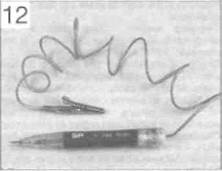
A simple test light can be used for voltage checks
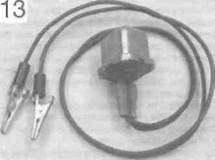
A buzzer is useful for voltage checks
• When using a meter, check that its leads are inserted in the correct terminals on the meter, red to positive (+ve), black to negative (-ve). Incorrect connections can damage the meter.
• A voltmeter (or multimeter set to the dc volts scale) should always be connected in parallel (across the load). Connecting it in series will destroy the meter.
• Voltage checks are made With the ignition ON.

|
| Checking for voltage at the rear brake light power supply wire using a meter... |
1 First identify the relevant wring circuit by referring to the wiring diagram at the end of this manual. If other electrical components share the same power supply (ie are fed from the same fuse), take note whether they are working correctly - this is useful information in deciding where to start checking the circuit.
2 If using a meter, check first that the meter leads are plugged into the correct terminals on the meter (see above). Set the meter to the dc volts function, at a range suitable for the battery voltage. Connect the meter red probe (+ve) to the power supply wire and the black probe to a good metal earth (ground) on the motorcycle's frame or directly to the battery negative (-ve) terminal (see Illustration 14). Battery voltage should be shown on the meter with the ignition switched ON.
3 If using a test light or buzzer, connect its positive (+ve) probe to the power supply terminal and its negative (-ve) probe to a good earth (ground) on the motorcycle's frame or directly to the battery negative (-ve) terminal (see illustration 15). With the ignition ON, the test light should illuminate or the buzzer sound.
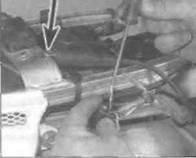
... or a test light - note the earth connection to the frame (arrow)
4 If no voltage is indicated, work back towards the fuse continuing to check for voltage. When you reach a point where there is voltage, you know the problem lies between that point and your last check point.
Checking the earth (ground)
• Earth connections are made either directly to the engine or frame (such as sensors, neutral switch etc. which only have a positive feed) or by a separate wire into the earth circuit of the wiring harness. Alternatively a short earth wire is sometimes run directly from the component to the motorcycle's frame.
• Corrosion is often the cause of a poor earth connection.
• If total failure is experienced, check the security of the main earth lead from the negative (-ve) terminal of the battery and also the main earth (ground) point on the wiring harness. If corroded, dismantle the connection and clean all surfaces back to bare metal.
1 To check the earth on a component, use an insulated jumper wire to temporarily bypass its earth connection (see illustration 16). Connect one end of the jumper wire between the earth terminal or metal body of the component and the other end to the motorcycle's frame.
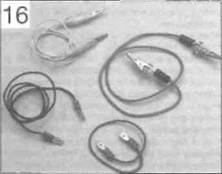
A selection of jumper wires for making earth (ground) checks
2 If the circuit works with the jumper wire installed, the original earth circuit Is faulty. Check the wiring lor open-circuits or poor connections. Clean up direct earth connections, removing all traces of corrosion and remake the joint. Apply petroleum jelly to the joint to prevent future corrosion.
Tracing a short-circuit
• A short-circuit occurs where current shorts to earth (ground) bypassing the circuit components. This usually results in a blown fuse.
• A short-circuit is most likely to occur where the insulation has worn through due to wiring chafing on a component, allowing a direct path to earth (ground) on the frame.
1 Remove any bodypanels necessary to access the circuit wiring.
2 Check that all electrical switches in the circuit are OFF, then remove the circuit fuse and connect a test light, buzzer or voltmeter (set to the dc scale) across the fuse terminals. No voltage should be shown.
3 Move the wiring from side to side whilst observing the test light or meter. When the test light comes on, buzzer sounds or meter shows voltage, you have found the cause of the short. It will usually shown up as damaged or burned insulation.
4 Note that the same test can be performed on each component in the circuit, even the switch.
ref-40 Technical Terms Explained
A
ABS (Anti-lock braking system) A system, usually electronically controlled, that senses Incipient wheel lockup during braking and relieves hydraulic pressure at wheel which is about to skid.
Aftermarket Components suitable for the motorcycle, but not produced by the motorcycle manufacturer.
Allen key A hexagonal wrench which fits Into a recessed hexagonal hole.
Alternating current (ac) Current produced by an alternator. Requires converting to direct current by a rectifier for charging purposes. Alternator Converts mechanical energy from the engine into electrical energy to charge the battery and power the electrical system. Ampere (amp) A unit of measurement for the flow of electrical current. Current = Volts i Ohms. Ampere-hour (Ah) Measure of battery capacity. Angle-tightening A torque expressed in degrees. Often follows a conventional tightening torque for cylinder head or main bearing fasteners (see illustration).
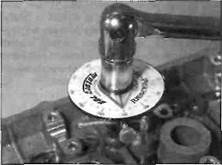
Angle-tightening cylinder head bolts
Antifreeze A substance (usually ethylene glycol)
mixed with water, and added to the cooling
system, to prevent freezing of the coolant in
winter. Antifreeze also contains chemicals to
inhibit corrosion and the formation of rust and
other deposits that would tend to clog the
radiator and coolant passages and reduce
cooling efficiency.
Anti-dive System attached to the fork lower leg
(slider) to prevent fork dive when bracing hard.
Anti-seize compound A coating that reduces
the risk of seizing on fasteners that are subjected
to high temperatures, such as exhaust clamp
bolts and nuts.
API American Petroleum Institute. A quality
standard for 4-stroke motor oils.
Asbestos A natural fibrous mineral with great
heat resistance, commonly used in the
composition of brake friction materials. Asbestos
is a health hazard and the dust created by brake
systems should never be inhaled or ingested.
ATF Automatic Transmission Fluid. Often Used
in front forks.
ATU Automatic Timing Unit. Mechanical device
for advancing the ignition timing on early
engines.
ATV All Terrain Vehicle. Often called a Quad.
Axial play Side-to-side movement.
Axle A shaft on which a wheel revolves. Also
known as a spindle.
В
Backlash The amount of movement between meshed components when one component is held still. Usually applies to gear teeth. Ball bearing A bearing consisting of a hardened Inner and outer race with hardened steel balls between the two races.
Bearings Used between two working surfaces to prevent wear of the components and a buildup of heat. Four types of bearing are commonly used on motorcycles: plain shell bearings, ball bearings, tapered roller bearings and needle roller bearings.
Bevel gears Used to turn the drive through 90°. Typical applications are shaft final drive and camshaft drive (see illustration).

Bevel gears are used to turn the drive through 90°
ВНР Brake Horsepower. The British
measurement for engine power output. Power
output is now usually expressed In kilowatts
(kW).
Bias-belted tyre Similar construction to radial
tyre, but with outer belt running at an angle to the
wheel rim.
Big-end bearing The bearing in the end of the
connecting rod that's attached to the crankshaft.
Bleeding The process of removing air from an
hydraulic system via a bleed nipple or bleed
screw.
Bottom-end A description of an engine's
crankcase components and all components
contained there-in.
BTDC Before Top Dead Centre in terms of piston
position. Ignition timing is often expressed in terms
of degrees or millimetres BTDC.
Bush A cylindrical metal or rubber component
used between two moving parts.
Burr Rough edge left on a component after
machining or as a result of excessive wear.
С
Cam chain The chain which takes drive from the
crankshaft to the camshaft(s).
Canister The main component in an evaporative
emission control system (California market only);
contains activated charcoal granules to trap
vapours from the fuel system rather than allowing
them to vent to the atmosphere.
Castellated Resembling the parapets along the
top of a castle wall. For example, a castellated
wheel axle or spindle nut.
Catalytic converter A device in the exhaust
system of some machines which converts certain
pollutants in the exhaust gases into less harmful
substances.
Charging system Description of the
components which charge the battery, ie the
alternator, rectifer and regulator.
Circlip A ring-shaped clip used to prevent
endwise movement of cylindrical parts and
shafts. An internal circlip is installed in a groove
in a housing; an external circlip fits into a groove
on the outside of a cylindrical
piece such as a shaft. Also known as a snap-ring.
Clearance The amount of space between two
parts. For example, between a piston and a
cylinder, between a bearing and a journal, etc.
Coil spring A spiral of elastic steel found in
various sizes throughout a vehicle, for example
as a springing medium in the suspension and in
the valve train.
Compression Reduction in volume, and
increase in pressure and temperature, of a gas,
caused by squeezing it into a smaller space.
Compression damping Controls the speed the
suspension compresses when hitting a bump.
Compression ratio The relationship between
cylinder volume when:he piston is at top dead
centre and cylinder volume when the piston is at
bottom dead centre.
Continuity The uninterrupted path in the flow of
electricity. Little or no measurable resistance.
Continuity tester Self-powered bleeper or test
light which indicates continuity.
Cp Candlepower. Bulb rating common found on
US motorcycles.
Crossply tyre Tyre plies arranged In a
criss-cross pattern. Usually four or six plies used,
hence 4PR or 6PR in tyre size codes.
Cush drive Rubter damper segments
fitted between the rear wheel and final drive
sprocket to absorb transmission shocks (see
illustration).

Cush drive rubbers dampen out transmission shocks
D
Degree disc Calibrated disc for measuring
piston position. Expressed in degrees.
Dial gauge Clock-type gauge with adapters for
measuring runout and piston position. Expressed
in mm or inches.
Diaphragm The rubber membrane in a master
cylinder or carburettor which seals the upper
chamber.
Diaphragm spring A single sprung plate often
used In clutches.
Direct current (do) Current produced by a dc
generator.
Technical Terms Explained ref-41
Decarbonisation The process of removing carbon deposits - typically from the combustion chamber, valves and exhaust port/system. Detonation Destructive and damaging explosion of fuel/air mixture in combustion chamber instead of controlled burning. Diode An electrical valve which only allows current to flow in one direction. Commonly used in rectifiers and starter interlock systems. Disc valve (or rotary valve) A induction system used on some two-stroke engines. Double-overhead camshaft (DOHC) An engine that uses two overhead camshats, one for the intake valves and one for the exhaust valves. Drivebelt A toothed belt used to transmit drive to the rear wheel on some motorcycles. A drivebelt has also been used to drive the camshafts. Dnvebelts are usually made of Kevlar. Driveshaft Any shaft used to transmit motion. Commonly used when referring to the final driveshaft on shaft drive motorcycles.
E
Earth return The return path of an electrical
circuit, utilising the motorcycle's frame.
ECU (Electronic Control Unit) A computer
which controls (for instance) an Ignition system,
or an anti-lock braking system.
EGO Exhaust Gas Oxygen sensor. Sometimes
called a Lambda sensor.
Electrolyte The fluid in a lead-acid battery.
EMS (Engine Management System) A
computer controlled system which manages the
fuel injection and the ignition systems in an
integrated fashion.
Endfloat The amount of lengthways movement
between two parts. As applied to a crankshaft,
the distance that the crankshaft can move side-
to-side in the crankcase.
Endless chain A chain having no joining link.
Common use for cam chains and final drive
chains.
EP (Extreme Pressure) Oil type used in
locations where high loads are applied, such as
between gear teetn.
Evaporative emission control system
Describes a charcoal filled canister which stores
fuel vapours from the tank rather than allowing
them to vent to the atmosphere. Usually only
fitted to California models and referred to as an
EVAP system.
Expansion chamber Section of two-stroke
engine exhaust system so designed to improve
engine efficiency and boost power.
Feeler blade or gauge A thin strip or blade of
hardened steel, ground to an exact thickness,
used to check or measure clearances between
parts.
Final drive Description of the drive from the
transmission to the rear wheel. Usually by chain
or shaft, but sometimes by belt.
Firing order The order in which the engine
cylinders fire, or deliver their power strokes,
beginning with the number one cylinder.
Flooding Term used to describe a high fuel level
in the carburettor float chambers, leading to fuel
overflow. Also refers to excess fuel in the
combustion chamber due to incorrect starting
technique.
Free length The no-load state of a component when measured. Clutch, valve and fork spring lengths are measured at rest, without any preload.
Freeplay The amount of travel before any action takes place. The looseness in a linkage, or an assembly of parts, between the initial application of force and actual movement. For example, the distance the rear brake pedal moves before the rear brake is actuated.
Fuel injection The fuel/air mixture Is metered electronically and directed into the engine intake ports (indirect injection) or into the cylinders (direct injection). Sensors supply information on engine speed and conditions. Fuel/air mixture The charge of fuel and air going into the engine. See Stoichiometric ratio. Fuse An electrical device which protects a circuit against accidental overload. The typical fuse contains a soft piece of metal which is calibrated to melt at a predetermined current flow (expressed as amps) and break the circuit.
G
Gap The distance the spark must travel in jumping from the centre electrode to the side electrode in a spark plug. Also refers to the distance between the Ignition rotor and the pickup coll in an electronic ignition system. Gasket Any thin, soft material - usually cork, cardboard, asbestos or soft metal - installed between two metal surfaces to ensure a good seal. For instance, the cylinder head gasket seals the joint between the block and the cylinder head.
Gauge An instrument panel display used to monitor engine conditions. A gauge with a movable pointer on a dial or a fixed scale is an analogue gauge. A gauge with a numerical readout is called a digital gauge. Gear ratios The drive ratio of a pair of gears in a gearbox, calculated on their number of teeth. Glaze-busting see Honing Grinding Process for renovating the valve face and valve seat contact area in the cylinder head. Gudgeon pin The shaft which connects the connecting rod small-end with the piston. Often called a piston pin or wrist pin.
H
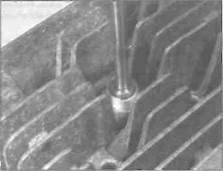
|
| Installing a Helicoil thread insert in a cylinder head |
Helical gears Gear teeth are slightly curved and produce less gear noise that straight-cut gears. Often used for primary drives.
Helicoil A thread insert repair system.
Commonly used as a repair for stripped spark
plug threads (see illustration).
Honing A process used to break down the glaze
on a cylinder bore (also called glaze-busting).
Can also be carried out to roughen a rebored
cylinder to aid ring beddlng-in.
HT High Tension Description of the electrical
circuit from the secondary winding of the ignition
coil to the spark plug.
Hydraulic A liquid filled system used to transmit
pressure from one component to another.
Common uses on motorcycles are brakes and
clutches.
Hydrometer An instrument for measuring the
specific gravity of a lead-acid battery.
Hygroscopic Water absorbing. In motorcycle
applications, braking efficiency will be reduced if
DOT 3 or 4 hydraulic fluid absorbs water from the
air - care must be ta<en to keep new brake fluid
in tightly sealed containers.
I
Ibf ft Pounds-force feet. An imperial unit of torque. Sometimes written as ft-lbs. Ibf in Pound-force inch. An imperial unit of torque, applied to components where a very low torque is required. Sometimes written as in-lbs. 1С Abbreviation for Integrated Circuit. Ignition advance Means of increasing the timing of the spark at higher engine speeds. Done by mechanical means (ATU) on early engines or electronically by the ignition control unit on later engines.
Ignition timing The moment at which the spark plug fires, expressed in the number of crankshaft degrees before the piston reaches the top of its stroke, or in the number of millimetres before the piston reaches the tcp of its stroke. Infinity (=■=} Description of an open-circuit electrical state, where no continuity exists. Inverted forks (upside down forks) The sliders or lower legs are held in the yokes and the fork tubes or stanchions are connected to the wheel axlo (spindle). Less unsprung weight and stiffer construction than conventional forks.
J
JASO Quality standard for 2-stroke oils. Joule The unit of electrical energy. Journal The bearing surface of a shaft.
К
Kickstart Mechanical means of turning the
engine over for starting purposes. Only usually
fitted to mopeds. small capacity motorcycles and
off-road motorcycles.
Kill switch Handebar-mounted switch for
emergency ignition cut-out. Cuts the ignition
circuit on all models, and additionally prevent
starter motor operation on others.
km Symbol for kilometre.
kph Abbreviation for kilometres per hour.
L
Lambda p.) sensor A sensor fitted in the exhaust system to measure the exhaust gas oxygen content (excess air factor).
ref.42 Technical Terms Explained
Lapping see Grinding.
LCD Abbreviation for Liquid Crystal Display. LED Abbreviation for Light Emitting Diode. Liner A steel cylinder liner inserted In a aluminium alloy cylinder block. Locknut A nut used to lock ал adjustment nut, or other threaded component, in place. Lockstops The lugs on the lower triple clamp (yoke) which abut those on the frame, preventing handlebar-to-fuel tank contact. Lockwasher A form of washer designed to prevent an attaching nut from working loose. LT Low Tension Description of the electrical circuit from the power supply to the primary winding of the ignition coil.
M
Main bearings The bearings between the
crankshaft and crankcase.
Maintenance-free (MF) battery A sealed
battery which cannot be topped up.
Manometer Mercury-filled calibrated tubes
used to measure intake tract vacuum. Used to
synchronise carburettors on multi-cylinder
engines.
Micrometer A precision measuring instrument
that measures component outside diameters
(see illustration).
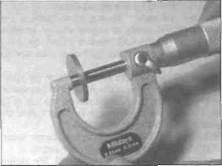
Tappet shims are measured with a micrometer
MON (Motor Octane Number) A measure of a
fuel's resistance to knock.
Monograde oil An oil with a single viscosity, eg
SAE80W.
Monoshock A single suspension unit linking the
swingarm or suspension linkage to the frame.
mph Abbreviation for miles per hour.
Multigrade oil Having a wide viscosity range (eg
10W40). The W stands for Winter, thus the
viscosity ranges from SAE10 when cold to
SAE40 when hot,
Multimeter An electrical test instrument with the
capability to measure voltage, current and
resistance. Some meters also Incorporate a
continuity tester and buzzer.
N
Needle roller bearing Inner race of caged
needle rollers and hardened outer race.
Examples of uncaged needle rollers can be found
on some engines. Commonly used in rear
suspension applications and In two-stroke
engines.
Nm Newton metres.
NOx Oxides of Nitrogen. A common toxic
pollutant emitted by petrol engines at higher
temperatures.
О
Octane The measure of a fuel's resistance to
knock.
OE (Original Equipment) Relates to
components fitted to a motorcycle as standard
or replacement parts supplied by the motorcycle
manufacturer.
Ohm The unit of electrical resistance. Ohms =
Volts -i- Current.
Ohmmeter An instrument for measuring
electrical resistance.
Oil cooler System for diverting engine oil
outside of the engine to a radiator for cooling
purposes.
Oil injection A system of two-stroke engine
lubrication where oil is pump-fed to the engine in
accordance with throttle position.
Open-circuit An electrical condition where there
is a break in the flow of electricity - no continuity
(high resistance).
O-ring A type of sealing ring made of a special
rubber-like material; in use, the O-ring is
compressed into a groove to provide the
Oversize (OS) Term used for piston and ring
size options fitted to a rebored cylinder.
Overhead cam (sohc) engine An engine with
single camshaft located on top of the cylinder
head.
Overhead valve (ohv) engine An engine with
the valves located In the cylinder head, but with
the camshaft located in the engine block or
crankcase.
Oxygen sensor A device installed in the exhaust
system which senses the oxygen content in the
exhaust and converts this Information into an
electric current. Also called a Lambda sensor.
P
Plastigauge A thin strip of plastic thread,
available in different sizes, used for measuring
clearances. For example, a strip of Plastigauge is
laid across a bearing journal. The parts are
assembled and dismantled; the width of the
crushed strip indicates the clearance between
journal and bearing.
Polarity Either negative or positive earth
(ground), determined by which battery lead is
connected to the frame (earth return). Modern
motorcycles are usually negative earth.
Pre-ignition A situation where the fuel/air
mixture ignites before the spark plug fires. Often
due to a hot spot In the combustion chamber
caused by carbon build-up. Engine has a
tendency to 'run-on'.
Pre-load (suspension) The amount a spring is
compressed when In the unloaded state. Preload
can be applied by gas. spacer or mechanical
adjuster.
Premix The method of engine lubrication on
older two-stroke engines. Engine oil is mixed
with the petrol in the fuel tank in a specific ratio.
The fuel/oil mix is sometimes referred to as
"petroil".
Primary drive Description of the drive from the
crankshaft to the clutch. Usually by gear or chain.
PS Pfedestarke - a German interpretation of
ВНР.
PSI Pounds-force per square inch. Imperial
measurement of tyre pressure and cylinder
pressure measurement.
PTFE Polytetrafluroethylene. A low friction
substance.
Pulse secondary air injection system A
process of promoting the burning of excess fuel present In the exhaust gases by routing fresh air into the exhaust ports.
Q
Quartz halogen bulb Tungsten filament surrounded by a halogen gas. Typically used for the headlight (see illustration).
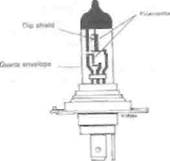
Quartz halogen headlight bulb construction
R
Rack-and-pinion A pinion gear on the end of a
shaft that mates with a rack (think of a geared
wheel opened up and laid flat). Sometimes used
In clutch operating systems.
Radial play Up and down movement about a
shaft.
Radial ply tyres Tyre plies run across the tyre
(from bead to bead) and around the
circumference of the tyre. Less resistant to tread
distortion than other tyre types.
Radiator A liquid-to-air heat transfer device
designed to reduce the temperature of the
coolant in a liquid cooled engine.
Rake A feature of steering geometry - the angle
of the steering head in relation to the vertical (see
| Steering geometry |
Illustration).
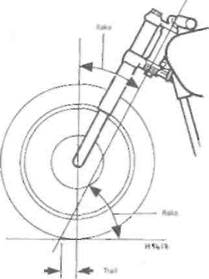
Technical Terms Explained ref.43
Rebore Providing a new working surface to the
cylinder bore by boring out the old surface.
Necessitates the use of oversize piston and
rings.
Rebound damping A means of controlling the
oscillation of a suspension unit spring after it has
been compressed. Resists the spring's natural
tendency to bounce back after being compressed.
Rectifier Device for converting the ac output of
an alternator Into dc for battery charging.
Reed valve An induction system commonly
used on two-stroke engines.
Regulator Device for maintaining the charging
voltage from the generator or alternator within a
specified range.
Relay A electrical device used to switch heavy
current on and off by using a low current auxiliary
circuit.
Resistance Measured in ohms. An electrical
component's ability to pass electrical current.
RON (Research Octane Number) A measure of
a fuel's resistance to knock.
rpm revolutions per minute.
Runout The amount of wobble (in-and-out
movement) of a wheel or shaft as it's rotated.
The amount a shaft rotates out-of-true'. The out-
of-round condition of a rotating part.
s
SAE (Society of Automotive Engineers) A
standard for the viscosity of a fluic.
Sealant A liquid or paste used to prevent
leakage at a joint. Sometimes used in
conjunction with a gasket
Service limit Term for the point where a
component is no longer useable and must be
renewed.
Shaft drive A method of transmitting drive from
the transmission to the rear wheel.
Shell bearings Plain bearings consisting of two
shell halves. Most often used as big-end and
main bearings in a four-stroke engine. Often
called bearing inserts.
Shim Thin spacer, commonly used to adjust the
clearance or relative positions between two
parts. For example, shims inserted into or under
tappets or followers to control valve clearances.
Clearance is adjusted by changing the thickness
of the shim.
Short-circuit An electrical condition where
current shorts to earth (ground) bypassing the
circuit components.
Skimming Process to correct warpage or repair
a damaged surface, eg on brake discs or drums.
Slide-hammer A special puller that screws into
or hooks onto a component such as a shaft or
bearing; a heavy sliding handle on the shaft
bottoms against the end of the shaft to knock the
component free.
Small-end bearing The bearing in the upper
end of the connecting rod at its joint with the
gudgeon pin.
Spalling Damage to camshaft lobes or bearing
journals shown as pitting of the working surface.
Specific gravity (SG) The state of charge of the
electrolyte in a lead-acid battery. A measure of
the electrolyte's density compared with water.
Straight-cut gears Common type gear used on
gearbox shafts and for oil pump and water pump
drives.
Stanchion The inner sliding part of the front
forks, held by the yokes. Often called a fork tube.
Stoichiometric ratio The optimum chemical
air/fuel ratio for a petrol engine, said to be 14.7
parts of air to 1 part of fuel.
Sulphuric acid The liquid (electrolyte) used in a
lead-acid battery. Poisonous and extremely
corrosive.
Surface grinding (lapping) Process to correct a
warped gasket face, commonly used on cylinder
heads.
T
Tapered-roller bearing Tapered inner race of caged needle rollers and separate tapered outer race. Examples of taper roller bearings can be found on steering heads. Tappet A cylindrical component which transmits motion from the cam to the valve stem, either directly or via a pushrod and rocker arm. Also called a cam follower.
TCS Traction Control System. An electronically-controlled system which senses wheel spin and reduces engine speed accordingly. TDC Top Dead Centre denotes that the piston Is at its highest point in the cylinder. Thread-locking compound Solution applied to fastener threads to prevent slackening. Select type to suit application.
Thrust washer A washer positioned between two moving components on a shaft. For example, between gear pinions on gearshaft. Timing chain See Cam Chain. Timing light Stroboscopic lamp for carrying out ignition timing checks with the engine running. Top-end A description of an engine's cylinder block, head and valve gear components. Torque Turning or twisting force about a shaft. Torque setting A prescribed tightness specified by the motorcycle manufacturer to ensure that the bolt or nut Is secured correctly. Undertightenlng can result in the bolt or nut coming loose or a surface not being sealed. Overtightening can result in stripped threads, distortion or damage to the component being retained. Tone key A six-point wrench. Tracer A stripe of a second colour applied to a
wire insulator to distinguish that wire from another one with the same colour insulator. For example, Br/W is often used to denote a brown insulator with a white tracer. Trail A feature of steering geometry. Distance from the steering head axis to the tyre's central contact point.
Triple clamps The cast components which extend from the steering head and support the fork stanchions or tubes. Often called fork yokes. Turbocharger A centrifugal device, driven by exhaust gases, that pressurises the intake air. Normally used to increase the power output from a given engine displacement. TWI Abbreviation for Tyre Wear Indicator. Indicates the location of the tread depth indicator bars on tyres.
и
Universal joint or U-joint (UJ) A double-pivoted connection for transmitting power from a driving to a driven shaft through an angle. Typically found in shaft drive assemblies. Unsprung weight Anything not supported by the bike's suspension (ie the wheel, tyres, brakes, final drive and bottom (moving) part of the suspension).
V
Vacuum gauges Clock-type gauges for
measuring intake tract vacuum. Used for
carburettor synchronisation on multi-cylinder
engines.
Valve A device through which the flow of liquid.
gas or vacuum may be stopped, started or
regulated by a moveable part that opens, shuts
or partially obstructs one or more ports or
passageways. The intake and exhaust valves in
the cylinder head are of the poppet type.
Valve clearance The clearance between the
valve tip (the end of the valve stem) and the
rocker arm or tappet/follower. The valve
clearance Is measured when the valve is closed.
The correct clearance is important - if too small
the valve won't close fully and will burn out,
whereas If too large noisy operation will result.
Valve lift The amount a valve is lifted off its seat
by the camshaft lobe.
Valve timing The exact setting for the opening
and closing of the valves in relation to piston
position.
Vernier caliper A precision measuring
instrument that measures inside and outside
dimensions. Not quite as accurate as a
micrometer, but more convenient.
VIN Vehicle Identification Number. Term for the
bike's engine and frame numbers.
Viscosity The thickness of a liquid or its
resistance to flow.
Volt A unit for expressing electrical "pressure" in
a circuit. Volts = current x ohms.
w
Water pump A mechanically-driven device for
moving coolant arourd the engine.
Watt A unit for expressing electrical power.
Watts = volts x current.
Wear limit see Service limit
Wet liner A liquid-cpoled engine design where
the pistons run in liners which are directly
surrounded by coolant (see illustration).
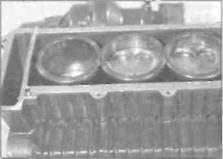
Wet liner arrangement
Wheelbase Distance from the centre of the front
wheel to the centre o: the rear wheel.
Wiring harness or loom Describes the electrical
wires running the length of the motorcycle and
enclosed in tape or plastic sheathing. Wiring
coming off the main harness is usually referred to
as a sub harness.
Woodruff key A key of semi-circular or square
section used to locate a gear to a shaft. Often
used to locate the alternator rotor on the
crankshaft.
Wrist pin Another name for gudgeon or piston
pin.
REF«44 Index
Note: References throughout this index are in the form - "Chapter number" • "page number"
| Camshaft drive gear assembly removal, inspection and installation - 2*22 Camshafts removal, inspection and installation-2*13 Carburettor - 4*4 disassembly, cleaning and inspection - 4»6 reassembly and float height check - 4«10 removal and Installation - 4*4 separation and joining - 4*8 synchronisation -1*15 Chain-0*13, 1*2 check, adjustment and lubrication -1 «6 removal, cleaning and installation - 6*23 Charging system leakage and output test - 9»22 Chemicals and Lubricants - REF»21 Choke cable check-1*14 removal and installation - 4*14 Clutch cable replacement - 2*30 check and adjustment -1»8 lever - 6«6 removal, inspection and installation - 2»25 switch check and replacement - 9*16 Compression check - 1*24 Connecting rods |
A
About this manual - 07 Acknowledgements - 0*7 Air ducts removal and installation - 8*5 Air fitter
cleaning -1*11
housing removal and installation - 4*3
renewal -1 «23 Air mixture adjustment - 4*4 Alternator check, removal and
installation - 9»22 Asbestos - 0*10
В
Battery-0*10
charging - 9*4
check -1*14
removal, installation, Inspection and maintenance - 9*3 Bleeding brake system - 7«14 Bodywork - 8»1 ef seq
air ducts - 8*5
fairing - 8*3
mirrors - 8*3
mudguard - 8*6
seat cowling - 8*2
seats - 8*2
trim panels - 8*5 Brake fluid- 0*12,1»2,1»20 Brake hoses inspection and
renewal-1»24, 7«13 Brake lever - 6*6
switch - 9*10 Brake light
bulb renewal - 9*7
check - 9*5
switches check and replacement - 9*10 Brake pedal removal and installation - 6*3 Brakes, wheels and tyres - 7»1 el seq
bleeding- 7«14
calipers - 7*4, 7»9
check-1*12
discs- 7»5, 7» 11
hoses, pipes and unions - 7*13
master cylinder - 7*6. 7*11
pads - 7»3, 7*8
sprocket coupling bearing - 7»19
tyres - 7»20
wheels - 7»14, 7*15, 7*16, 7*17 Buying spare parts - 0*8
С
Cables - 2*30. 4»12, 4*14, 9*11 check - 1»14 lubrication -1*10 Calipers removal, overhaul and installation front - 7«4 rear - 7»9 seals renewal -1 «24
Camshaft drive gear assembly removal,
inspection and installation - 2*22 Camshafts removal, inspection and
installation-2*13 Carburettor - 4*4
disassembly, cleaning and inspection - 4»6
reassembly and float height check - 4«10
removal and Installation - 4*4
separation and joining - 4*8
synchronisation -1*15 Chain -013, 1*2
check, adjustment and lubrication -1 «6
removal, cleaning and installation - 6*23 Charging system leakage and output
test - 9»22 Chemicals and Lubricants - REF»21 Choke cable
check-1*14
removal and installation - 4*14 Clutch
cable replacement - 2*30
check and adjustment -1»8
lever - 6«6
removal, inspection and installation - 2»25
switch check and replacement - 9*16 Compression check - 1*24 Connecting rods
bearings - 2»40, 2»42
removal, inspection and installation - 2*41 Contents - 0»2 Conversion factors - REF»20 Coolant - 0*13, 1»2 Cooling system - 3*1 et seq
check-1*12
draining, flushing and refilling -1*23
fan and switch - 3«3
hoses - 3«8
pressure cap - 3»2
radiator - 3*6
reservoir - 3*2
temperature gauge and sender - 3»4, 9» 13
thermostat and thermostat housing - 3*4
water pump - 3»6 Crankcase halves
inspection and servicing - 2*40
separation and reassembly - 2*37 Crankshaft removal, inspection and
installation - 2*46 Cylinder block removal, inspection and
installation - 2*2 Cylinder bores inspection and
servicing - 2*40 Cylinder compression check -1»24 Cylinder head
disassembly, inspection and reassembly - 2*18
removal and installation - 2*16
D
Da/7y (pre-ride) checks - 0*11 ef seq brake fluid -012,1»2 chain -013, 1*2
coolant - 0*13, 1*2
engine/transmission oil - 0*11.1*2
final drive -f> 13,1»2
fuel -014
legal and safety checks - 0*14
lighting - 0*14
pressures - 0*14
safety - 0*14
signalling - 0*14
steering - 013
suspension - 013
tread depth - 014
tyre pressures - 0»14 Dimensions - REF»1 Diode check and replacement - 9» Discs inspection, removal and
installation
front - 7»5
rear-7*11 Drive chain
check, adjustment and lubrication
removal, cleaning and installation - 6»23
E
Electrical system - 9*1 ef seq
alternator - 9*22
battery - 9»3, 9*4
brake lever switch - 9*10
brake light - 9»5, 9*7, 9» 10
charging system - 9*22
clutch switch - 9»16
diode-9» 17
fault finding - 9*3
fuses - 9*4
handlebar switches - 9»is
headlight - 9»5. 9»6
horn - 9» 17
ignition (main) switch - 9*14
indicators - 9*5, 9*8, 9»9
instruments - 9»5, 9*11, 9*12, 9*13
lighting system - 9*5
neutral switch - 9*15
oil pressure switch - 9» 14
regulator/rectifier - 9*24
sidelight - 9»6
sidestand switch - 9"16
speedometer- 9*11. 9*12.
starter motor - 9*18,9*19
starter relay - 9*17
tachometer - 9*13
tail light - 9»5, 9»8
temperature gauge - 9»13
turn signal lights - 9»5. 9*8. 9«9
warning light bulbs - 9*13
warning lights - 9*5 Electricity-0*10 Engine oil pressure
check-1*25
switch check, removal and installation - 9»14
IndeX REF.45
Engine, clutch and
transmission - 2«1 ef seq
camshafts-2» 13, 2*22
clutch - 2«25, 2*30
connecting rod bearings - 2»40,2*41, 2*42
crankcase halves - 2»37, 2«40
crankshaft - 2»46
cylinder block - 2*2
cylinder bores - 2*40
cylinder head - 2»16, 2»18
gearchange mechanism -?»34
idle/reduction gear - 2*24
main bearings - 2*40, 2*47
oil cooler - 2«12
oil pump - 2 «32
oil sump, oil strainer and pressure relief valve - 2»31
piston rings - 2«45
pistons - 2*44
removal and Installation - 2*1
running-in procedure - 2*57
selector drum and forks - 2*54
starter clutch - 2»24
start-up after overhaul - 2»56
transmission shafts - 2*48, 2*49
valve cover - 2» 12
valves/valve seats/valve guides - 2» 18 Engine/transmission oil - 0*11, 1*2
change- 1*10,1*13 Exhaust system removal and
installation - 4*14
Fairing panels removal and installation - 8*3 Fan check and replacement - 3»3 Fault finding - REF»28 ef seq
braking problems - REF»35
clutch problems - REF«32
driveline noise - REF»33
electrical problems - 9*3, REF»36
engine doesn't start or is difficult to start - REF«29
engine noise - REF«33
exhaust smoke - REF»34
frame and suspension noise - REF»34
gearchanging problems - REF»33
oil pressure warning light comes on - REF«34
overheating - REF»32
poor handling or stability - REF»35
poor running at low speed - REF»30
poor running or no power at high speed - REF«31 Fault Finding Equipment - REF»37 ef seq Filter
air-1 «11,1 «23, 4*3
fuel -1*14
oil-1*13 Final drive - 0*13, 1»2, 1*6, 6»23 Fire- 0*10
Float height check - 4»10 Footrests removal and installation - 6*3 Forks-6»19
disassembly, inspection and reassembly - 6*8
oil-1*2, 1»25
removal and installation - 6*6
Frame, suspension and final
drive - 6«1 ef seq
brake lever - 6*6
brake pedal - 6*3
chain - 6»23
clutch lever - 6*6
footrests - 6»3
forks - 6*6. 6»8, 6«19
frame - 6»2
gearchange lever - 6*3
handlebars - 6*4
handlebar levers - 6*6
shock absorber - 6*17, 6*20
sidestand - 6*4
sprockets - 6*23, 6»25
steering head bearings - 6»16
steering stem - 6*15
suspension - 6*18, 6«19
swingarm - 6*20, 6*22 Fuel - 014 Fuel and exhaust systems - 4*1 ef seq
air filter housing - 4»3
carburettor - 4»4, 4»6, 4»8, 4»10
choke cable-4*14
exhaust system - 4*14
fuel pump - 4*15
fuel tank and fuel tap - 4«2,4*3
idle fuel/air mixture adjustment - 4*4
throttle cables-4*12 Fuel filter cleaning - 1»14 Fuel hoses renewal -1 «24 Fuel pump check, removal and
installation - 4«15 Fuel system check -1 "14 Fuel tank
cleaning and repair - 4*3
removal and installation - 4«2 Fuel tap removal and installation - 4«2 Fumes- 0*10 Fuses check and renewal - 9*4
Gearchange lever removal and
installation - 6*3 Gearchange mechanism removal,
inspection and installation - 2»34 Glossary - REF«40 ef seq Grey imports - 0*8
H
Handlebar switches
check - 9*15
switches removal and Installation - 9*15 Handlebars and levers removal and
installation - 6»4 Headlight
aim check and adjustment -1*17
assembly removal and installation - 9*6
bulb renewal - 9*6
check - 9»5 Horn check and replacement - 9»17 HT coils check, removal and
installation - 5»3
Identification numbers - 0*8 Idle fuel/air mixture adjustment - 4*4 Idle speed check and adjustment -1»7 Idle/reduction gear removal, inspection
and installation - 2«24 Ignition (main) switch check, removal and
installation - 9*14 Ignition system - 5*1 ef seq
check - 5*2
control unit - 5»5
HT coils - 5«3
pulse generator coil - 5*4
throttle position sensor - 5*6
timing - 5*5 Imports - 0«8 Indicators -014
assemblies removal and installation - 9*9
bulbs renewal - 9*8
circuit check - 9*8
lights check - 9*5 Instruments
check and replacement - 9» 12
removal and installation - 9»11 Instrument lights
bulbs renewal - 9*13
check - 9«5 Introduction - 0*4
Legal and safety checks - 014 Levers removal and installation - 6*6 Lighting - 0*14
check - 9»5 Lubricants - REF»21
M
Main bearings - 2»40
shell selection - 2*47 Maintenance schedule -1»3 Master cylinder
removal, overhaul and installation front - 7*6 rear-7»11
seals renewal -1 «24 Mirrors removal and installation - 8»3 Model years - 0*8 MOT Test Checks - REF«22 ef seq Mudguard removal and installation - 8*6
N
Neutral switch check, removal and
installation - 9*15 Nuts and bolts tightness check -1»20
Oil
chain -1»2
engine/transmission - 0*11, 1*2, 1«10, 1-13.1-25
forks-1 «2. 1»25 Oil cooler removal and installation - 2*12 Oil fitter change - 1-13
ref»46 Index
Oil pressure
check -1 «25
switch check, removal and installation - 9*14 Oil pump removal, inspection and
installation - 2*32 Oil sump removal, inspection and
installation - 2*31
P
Pads
renewal front - 7«3 rear - 7*8
wear check -1 «8 Parts - 0*8
Piston rings inspection and installation - 2*45 Pistons removal, inspection and
installation - 2*44 Pivot points lubrication - 1*9 Pressure cap check - 3*2 Pressure relief valve removal, inspection
and installation - 2»31 Pulse generator coil assembly check,
removal and installation - 5*4
R
Radiator removal and installation - 3*6 Regulator/rectifier check and
replacement - 9*24 Reservoir removal and installation - 3*2 Routine maintenance and
servicing -1»1 ef seq
air filter -1»11,1*23
battery -1*14
brake hoses -1*24
brake system -1»12
brake fluid -1 «20
cables- 1*10
caliper seals -1 «24
carburettors- 1»15
chain and sprockets -1*6
choke cable-1«14
clutch -1»8
cooling system -1*12.1*23
cylinder compression - 1 «24
drive chain and sprockets -1*6
engine/transmission oil and oil filter-1*10, 1*13
fork oil- 1*25
fuel hoses -1 «24
fuel system -1*14
headlight aim -1*17
idle speed -1«7
maintenance schedule -1*3
master cylinder seals -1 «24
nuts and bolts -1 «20
oil pressure -1»25
pads-1»8
pivot points -1»9
sidestand -1»17
spark plugs-1*8,1*15
stand -1»9
steering head bearings -1 «18,1*25
suspension -1*17
swlngarm and suspension linkage bearings -1«25
throttle cables -1*14 tyres -1*11
valve clearances -1»20 wheel bearings -1 «20 wheels -1»11 Running-in procedure - 2»57
s
Safety first!-0*10, 0*14
Seals -1»24
Seats
cowling removal and installation - 8*2
removal and Installation - 8*2 Selector drum and forks removal,
inspection and installation - 2*54 Shock absorber - 6*20
removal, inspection and installation - 6*17 Sidelight bulb renewal - 9*6 Sidestand
check - 1»17
removal and installation - 6*4
switch check and replacement - 9*16 Signalling - 0*14 Spare parts - 0*8 Spark plugs
gaps check and adjustment -1»8
renewal -1*15 Speedometer
cable removal and installation - 9»11
check and replacement - 9*12 Sprockets
check and renewal -1*6, 6*23
coupling/rubber damper bearing - 7*19
check and renewal - 6*25 Stand, lever pivots and cables
lubrication -1*9 Starter clutch and idle/reduction gear
removal, inspection and
installation - 2»24 Starter motor
disassembly, inspection and reassembly - 9*19
removal and installation - 9* 18 Starter relay check and replacement - 9»17 Start-up after overhaul - 2*56 Steering - 0*13 Steering head bearings
check and adjustment -1*18
inspection and renewal - 6*16
lubrication -1«26 Steering stem removal and
installation - 6»15 Storage - REF»26 ef seq Sump removal, inspection and
installation - 2*31 Suspension - 0*13
adjustments-6*19
check-1»17 Suspension linkage
bearings lubrication -1»25
removal, Inspection and installation - 6*18 Swingarm
bearings lubrication -1*25
inspection and bearing renewal - 6*22
removal and installation - 6*20 Switches - 3*3. 9» 10, 9»14. 9*15, 9*16
T
Tachometer check and replacement - 9» 13 Tail light
assembly removal and installation - 9*8
bulb renewal - 9*7
check - 9»5 Technical Terms Explained - REF«40 ef seq Temperature gauge - 9*13
check and replacement - 3*4 Thermostat and thermostat housing
removal, check and installation - 3*4 Throttle cables
check- 1*14
removal and installation - 4*12 Throttle position sensor check and
replacement - 5*6 Timing general information and
check - 5*5 Tools and Workshop Tips - REF«2 ef seq Transmission shafts
disassembly, inspection and reassembly - 2*49
removal and installation - 2*48 Trim panels removal and installation - 8*5 Turn signals - 0*14
assemblies removal and installation - 9»9
bulbs renewal - 9»8
circuit check - 9*8
lights check - 9*5 Tyres - 0*14
check -1»11
depth - 0*14
general information and fitting - 7*20
pressures - 0*14
и
Unofficial (grey) imports - 0*8
V
Valve clearances check and
adjustment - 1 «20 Valve cover removal and installation - 2*12 Valves/valve seats/valve guides - 2» 18
w
Warning lights
bulbs renewal-9*13
check - 9»5 Water pump check, removal and
installation - 3*6 Weights - REF«1 Wheel bearings
check -1»20
renewal - 7*17 Wheels
alignment check - 7» 14
general check -1*11
inspection and repair - 7»14
removal and installation front-7*15 rear-7*16 Wiring diagams - 9»26 ef seq Workshop Tips - REF«2 ef seq
Haynes Motorcycle Manuals - The Complete List
Title
Book No. Title
Book No. Title
Book No.
KAWASAKI
| HARLEY-DAVIDSON |
| Honda MB, M8X, MT 8 MTX50 (80 - 93) Honda C50, C70 & C90 (67 - 99) |
| Honda CR80R & CR125R (86 - 97) |
| Honda XR80R&XR100R (85 -96) |
| Honda XL/XR 80,100,125,18 Models (78 • 87) |
| 1200 2-valve |
| Honda CB100N&CB125N (78-i |
| Honda H100 S H100S Singles (80-92) |
| Honda CB/CD126T & CM125C Twins (77 - 88) |
| Honda CG125 (76 - 94) |
| HondaNS125(86-93) |
| Honda MBX/MTX125 & MTX200 (83 - 93) |
| Honda XUXR 250 & 500 (78 - 84) |
| Honda XR250L, XR250R & XR4QOR (86 - 97) |
| Honda CB250RS Singles (80 • 84) |
| Honda CR250R & CR500R (86 - 97) |
| Honda Elsinore 250 (73 - 75) Honda CBR400RR Fours (88 - 99) |
| Honda CB-IOO S CB550 Fours (73 - 77) |
| Honda CX7GL500 & 650 V-Twins (78 - 86) |
| Honda CBX550 Four (82 - 86) |
| Honda XL600R 8 XR600R (83 - 96) |
| Honda CBR600F1 & 1Q00F Fours (87 - 96) |
| Honda CBR600F2 j F3 Fours (91 - 98) |
| Honda CB650 sohc Fours (78 - 84) Honda NTV600 8 650 V-Twins (88 - 96) Honda CB750 sohc Four (69 - 79) Honda V45/65 Sabre 8 Magna (82 - 88) |
| Honda VFR750 8 700 V-Fours (86 - 97) Honda CB750 8 CB900 done Fours (78 - 84) Honda CBR900RR FireBlade (92 - 97) Honda ST1100 Pan European V-Fours (90 - 97) |
| Honda GL1000 Gold Wing (75 -79) |
| Honda GL1100 Gold Wing (79-81) Honda Gold Wing 1200 (USA) (84 - 87) |
| Honda Gold Wing 1500 (USA) (88 - 98) |
| О 1255 |
| Kawasaki AE'AR 50 8 80 [81 - 95) |
| BMW 2-valve rwins (70 ■ 96) | |
| BMW K100 S 75 2-valve Models (83 - 96) | |
| BMW R850 & R1100 4-valve Twins (93 ■ 97) | |
| Е2И | |
| BSA Bantam (48-71) | |
| BSA Unit Singles (58 • 72) | |
| BSA Pre-unit Singles (54 -61) | |
| BSA A7 SAW Twins (47-62) |
1007 Yamaha RD50 S 80 (78 - 89)
| Kawasaki КС, КЕ&КН100 (75-93) |
| 'У 0800 |
1371 Yamaha DT50 & 80 Trail Bikes [78 • 95)
| Kawasaki AR125 (82-94) |
| О 1247 |
' 1006 Yamaha T50 & 80 Townmate (83 • 95)
| Kawasaki KMX125 & 200 (86 - 96) |
| О 0474 |
О 3046 Yamaha YB100 Singles (73-91)
| Kawasaki 250. 350 & 400 Triples (72 - 79) |
0134 Yamaha 100.125 8 175 Trail bikes (71 - 85)_
| Kawasaki 400 8 440 Twins (74 - 81) |
0281 Yamaha RS/RXS100 8 125 Singles (74 - 95)_
| Kawasaki 400. 500 & 550 Fours (79 - 91) |
| О 0887 |
0910 Yamaha RD & DT125LC (82 -87)
| Kawasaki EW460 & 500 Twins (Ltd/Vulcan) (65 - 93) 2053 Kawasaki EX & ER50D (GPZ500S & ER-5) Twins (87 - 99) _____________________________________ 2052 Kawasaki ZX600 (Nln)a ZX-6, ZZ-R600) Fours (90 - 97) 2146 Kawasaki ZX-6R Hinja Fours (95 - 98) _________________ 3541 Kawasaki ZX600 (GPZ600R, GPX600R, Ninja 600R & RX) & ZX750 (GPX750R, Ninja 750R) Fours (85 ■ 97) 1780 |
Yamaha TZR125 (87 - 93) 8 DT125R (88 - 95) О 1655
| в 0464 |
| BSA A50 8 A65 Twins (62 - 73)0155 Bullaco Competition Bikes (72 - 751 0219 |
Yamaha TY50, 80, 125 & 175(74-84)
Yamaha XI 8 SR125 (82 ■
| 0040 0378 0803 1158 0333 0342 0821 2100 |
Yamaha 250 & 350 Twins (70 - 79)
| CZ 125 &I75 Singles (69 -90)0185 Ducali 600, 750 & 900 2-valve V-Twins 191 - 96) 3290 |
Yamaha X5250.360 8 400 sohc Twins (75-84) Yamaha RD250 8 350LC Twins (80 - 82)
| Kawasaki 650 Four (76 - 78) |
Yamaha RD350 YPVS Twins (83 - 95) ___________
| Kawasaki 750 Air-cooled Fours (80 - 91) |
Yamaha RD400 Twin (75 -79) _______________
| Kawasaki ZR550 & 750 Zephyr Fours (90 - 97) |
| Harley-Davidson Sportsters (70 - 97) __________________ 0702 Harley-Davidson Big Twins (70 - 97) Honda NB. ND. NP & NS50 Melody (81 - 85) Honda NE/NB50 Vision 8 SA50 Vision Met-in (85 - 95) О 1278 0731 0324 |
| Kawasaki ZX750 (Nln)a ZX-7 & ZXR750) Fours (89 ■ 96) 2054 Kawasaki 900 8 1000 Fours (73 - 77) 0222 |
Yamaha XT, TT 8 SR500 Singles (75 - 83)
Yamaha XZ550 Vision V-Twins (82 - 85)
Yamaha FJ, FZ, XJ 8 YX600 Radian (84 - 92)______

|
| Kawasaki ZX900,1000 & 1100 Liquid-cooled Fours (83 - 97) |
| 2145 0341 |
| О 0622 |
Yamaha XJ600S (Seca II. Diversion) 8 XJ600N
Fours (92 - 99) _____________________________
Дата добавления: 2015-10-29; просмотров: 643 | Нарушение авторских прав
| <== предыдущая страница | | | следующая страница ==> |
| Float-type hydrometer for measuring battery specific gravity | | | Электронный путеводитель – Рынок труда. |